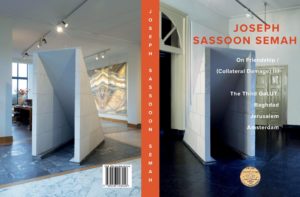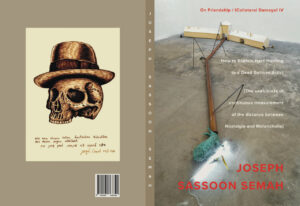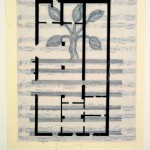Joseph Sassoon Semah: On Friendship / (Collateral Damage) IV – How to Explain Hare Hunting to a Dead German Artist
The richly illustrated publication:
Joseph Sassoon Semah: On Friendship / (Collateral Damage) IV – How to Explain Hare Hunting to a Dead German Artist [The usefulness of continuous measurement of the distance between Nostalgia and Melancholia] will be published in March 2023 on Joseph Beuys and post-war West German art history.
Published by Metropool Internationale Kunstprojecten, final editing: Linda Bouws & Joseph Sassoon Semah, design + layout: kunstburo geert schriever, A4, 208 pages, full colour – ISBN 9789090368399
The publication can now be ordered € 49.95 and € 5 shipping costs: Stichting Metropool Internationale Kunstprojecten, account number NL 42 INGB 0006 9281 68 stating On Friendship IV, name and address.
With contributions from
Joseph Sassoon Semah, Linda Bouws (curator), David de Boer (general practitioner and gallery owner), Albert Groot (psychiatrist), Paul Groot (art historian) Arie Hartog (director Gerhard-Marcks-Haus, Bremen), Bas Marteijn (Chief Country Officer Deutsche Bank Netherlands), Eelco Mes (curator), Markus Netterscheidt (artist), Ton Nijhuis (director Duitsland Instituut/UvA), Hans Peter Riegel (author of the four-volume biography Beuys, Die Biographie), Mati Shemoelof (author), Rick Vercauteren (former director Museum Bommel van Dam, publicist and historian), Andreas Wöhle (President Evangelical Lutheran Synod in the Protestant Church).
Brief description
The publication highlights Beuys’ work and thought from different perspectives and his relationship to post-war culture and politics in particular.
Joseph Sassoon Semah’s (1948, Baghdad) work – drawings, paintings, sculptures, installations, performances and texts – provides ample space for critical reflection on identity, history and tradition and is part of the artist’s long research into the relationship between Judaism and Christianity as sources of Western art and culture and of politics.
Joseph Beuys (1921, Krefeld -1986, Düsseldorf) is one of Germany’s most influential post-war artists, who became particularly famous for his performances, installations, lectures and Fluxus concerts. In 2021/22, Joseph Beuys’ 100th birthday was celebrated extensively with the event ‘Beuys 2021. 100 years’.
But who was Beuys really? Joseph Beuys mythologised his wartime past as a national socialist and Germany’s problematic and post-traumatic past. After WWII, Beuys transformed from perpetrator to victim. How should we interpret Beuys in the future?
Joseph Beuys and Joseph Sassoon Semah, two ex-soldiers, two artists. Joseph Beuys was a former gunner and radio operator in the German air force during WWII; Joseph Sassoon Semah served in the Israeli air force. Who is the (authentic) victim and who is the Victimiser?
Joseph Sassoon Semah – On Friendship/(Collateral Damage) III – The Third GaLUT: Baghdad, Jerusalem, Amsterdam
 Joseph Sassoon Semah – On Friendship/(Collateral Damage) III – The Third GaLUT: Baghdad, Jerusalem, Amsterdam.
Joseph Sassoon Semah – On Friendship/(Collateral Damage) III – The Third GaLUT: Baghdad, Jerusalem, Amsterdam.
Stichting Metropool Internationale Kunstprojecten. 220 pag. A4 formaat. ISBN 978 90 361 0601 6. Euro 39,95
On Friendship/(Collateral Damage) III – The Third GaLUT: Baghdad, Jerusalem, Amsterdam is een poëtische en kritische zoektocht van kunstenaar Joseph Sassoon Semah naar de steden Amsterdam, Bagdad en Jerusalem. Deze steden waren van oudsher gastvrije en tolerante toevluchtsoorden. Zijn ze dat vandaag nog? Wat is de plek voor ‘De Gast’, degene die in een vreemde context leeft en werkt en zijn omgeving toetst op het moment dat hij zijn specifieke positie als ’Gast’ in ballingschap zonder enig voorbehoud toont en zijn plaats opeist? De Gast wordt Gastheer. Deze bijzondere kunstmanifestatie gaat over twee onlosmakelijke grootheden: de dynamiek van de derde ballingschap en de evolutie van Gast naar Gastheer.
Het boek bevat een uitgebreid overzicht van de kunstmanifestatie.
Met bijdragen van:
Prof. Dr. Emile Schrijver (algemeen directeur Joods Cultureel Kwartier Amsterdam) – Oreach Natah Lalun: Reflections on the concept of the Jewish artist as Guest
Joseph Sassoon Semah – THE THIRD גלות GaLUT. Remapping the Memory of the Guest
Dr. Arie Hartog (directeur Gerhard-Marcks-Haus, Bremen) The Third Exile: recovering the traditions of asymmetry
Dr. Margriet Schavemaker (artistiek directeur Amsterdam Museum) Compelling footnotes Joseph Semah and the Stedelijk Museum Amsterdam
Professor dr. Ella Shohat (New York University) Remainders Revisited: An Exilic Journey from Hakham Sasson Khdhuri to Joseph Sassoon Semah
Rick Vercauteren (publicist en historicus) From deliberate destruction to concise reconstructions
Mati Shemoelof (dichter en auteur Berlijn) How to Explain Hair hunting to a Dead German Artist
Dr. Yael Almog (Durham University) Ritual Judaism: Ages of Diaspora
Linda Bouws (Metropool Internationale Kunstprojecten) Joseph Sassoon Semah: Re-thinking the concept of the GaLUT, re-claiming the lost culture
Het boek is te bestellen bij Stichting Metropool Internationale Kunstprojecten, € 39,95 excl. verzendkosten, rek.nr. NL 42 INGB 0006 9281 68 o.v.v. On Friendship III, naam en adres.
On Friendship / (Collateral Damage) II- The Guardians of the Door – Reflection on Kazimir Malevich
On Friendship / (Collateral Damage) II- The Guardians of the Door – Reflection on Kazimir Malevich
Stedelijk Museum Amsterdam
Sunday 22 October 2017
Reflection on Kazimir Malevich:
The Naked Square / EIRUV ChaTzeROT (Amalgamation of Courts) Black upon White in the Memory of the Destruction
[of the second BET Ha-MiKDaSh]
On Friendship / (Collateral Damage) II – The Guardians of the Door
(22 June 2017 – January 2018) Luther and 500 years of Reformation are the central subjects: art, performances, artistic interventions, round-table conversations, lectures and a book publication. A critical reflection on the image of Luther as a ‘superstar’ and on his importance then and now.
http://www.josephsemah.nl/onfriendship2.html
Jom Semah – cyclist
Peter Baren – the House Painter
Baruch Abraham – translator of Joseph Sassoon Semah’s mother language (Hebrew)
Renée Hartog – the Conductor
Bülent Evren, Ferdinand van Dieten, Tom Bouws, Ton Nijhuis, Joseph Sassoon Semah – the Chorus of the Void
Camera – Estella Chia-Min-Fang
Editing – Bob Schoo, https://www.youtube.com/channel/
Photography – Ilya Rabinovich
© Metropool International Art Projects, curator: Linda Bouws, 2017/2018
On Friendship / (Collateral Damage) II – The Guardians Of The Door – Stedelijk Museum Amsterdam 2017
On Friendship / (Collateral Damage) II – The Guardians of the Door – Stedelijk Museum Amsterdam – Friday 20 October 2017
Reflection on Joseph Beuys 2017/1986 – Joseph Sassoon Semah: How to explain hare hunting to a dead German artist
In On Friendship / (Collateral Damage) II – The Guardians of the Door Luther and 500 years of Reformation are the central subject: with art, performances, artistic interventions, round-table conversations, lectures and a book publication. A critical reflection on the image of Luther as a ‘superstar’ and on his importance then and now. The Nieuwe Kerk, The Joods Historisch Museum, the Stedelijk Museum and the Goethe-Institut are all partners in this project.”
http://www.josephsemah.nl/onfriendshi…
Location Stedelijk Museum Amsterdam, Friday 20th October 2017/1986 Reflection on Joseph Beuys:
Jom Semah – cyclist
Peter Baren – reading through a megaphone excerpt from – Martin Luther/On the Jews and Their Lies 1543
Baruch Abraham – translator of Joseph Sassoon Semah’s mother language [Hebrew]
Anastasia Kozlova – violinist [Adagio by Johann Sebastian Bach] Masja Austen – the symbolic surrogate mother
Emile Schrijver – General director of the Jewish Historical Museum Amsterdam – Mirror-image
Margriet Schavemaker – Head of Collections and Research Stedelijk Museum Amsterdam
Joseph Sassoon Semah – the Guest
With thanks to the Nieuwe Kerk, the Jewish Historical Museum, the Stedelijk Museum, the Goethe-Institut, Fonds Kerk en Wereld, Gravin van Bylandt Stichting, Haëlla Stichting, Kattendijke/Drucker Stichting, Mondriaan Stichting, De Vrijzinnige Fondsen, and to everyone who helped and contributed to On Friendship / (Collateral Damage) II – The Guardian of the Door
Camera, editing and photography: Estella Chia-Min-Fang, Bob Schoo, Ilya Rabinovich
© Metropool International Art Projects, curator: Linda Bouws, 2017/2018
Jewish Art: Not In Heaven – Artists As Partners In Creation
Curators Judith Cardozo and Dr. Susan Nashman Fraiman present The exhibition “Not in Heaven”, which was part of the Jerusalem Biennale 2019. The exhibit was a response of designers and artists to a dramatic story from the Talmud.
The presentation includes individual items from the exhibition itself, as well as musings on the role of Jewish texts as sources of inspiration for artists.
More info: https://jewishartsalon.org/2020/04/21/not-in-heaven-artists-as-partners-in-creation/
Dr. Susan Nashman Fraiman is a lecturer, researcher and curator of Jewish and Israeli art. She has taught at Hebrew College in Newton, Ma, the Pardes Institute of Jewish Studies and currently teaches at the Rothberg School for Overseas Students. She served for five years as the collection manager at the Yad Vashem Art Museum and curated the exhibit “The Fine Line” in the 2015 Jerusalem Biennale.
Website: www.artinisrael.net
Born in New York City, Judy Cardozo, Independent Curator and writer, educated at Pratt Institute and Barnard College, worked at the National Foundation for Jewish Culture and curated exhibitions at the Bronx Museum, Yeshiva University Museum and the Bertha Urdang Gallery. In Toronto, she was curator of the Beth Tzedec Museum and and co-produced the ASHKENAZ Festival at Harbourfront. In Israel since 2000, she worked at the Center for Jewish Art and has been involved with the Jerusalem Biennale.
Organized and hosted by the Jewish Art Salon; co-sponsored by Art Kibbutz and Jada Art.
Edited by Jonah Rubin-Flett. Assistance by Bluma Gross.
Ella Shohat ~ Remainders Revisited: An Exilic Journey from Hakham Sasson Khdhuri To Joseph Sassoon Semah
SPUI25 – Amsterdam – December 2, 2019
Keynote Lecture Professor Ella Shohat (New York University):
‘Remainders Revisited: An Exilic Journey from Hakham Sassoon Khdhuri to Joseph Sasson Semah’. She reflected on the significance of a place in the narration of the displaced Jewish-Iraqi community in the wake of overpowering political forces that, in one form or another, generated a historical vortex that rendered impossible a millennial existence in Mesopotamia.The enormous task of shepherding a Jewish community massively impacted by internal and external political pressures after the fall of the Ottoman empire and the establishment of the state of Iraq fell largely on the shoulders of the Hakham Bashi (the Chief Rabbi and also the President of the Iraqi Jewish Community), Sasson Khdhuri, the grandfather of artist Joseph Sassoon Semah. Although the majority of Iraqi Jews were dislocated in the wake of the partition of Palestine and the establishment of the state of Israel, the Hakham stayed to safeguard those who remained in Iraq, living through wars, revolutions, and a dictatorial regime that rendered hellish the situation of all Iraqis, but especially of Jews, existing as they did under the unrelenting suspicion of disloyalty. At the same time, some of the Hakham’s children moved to Israel where the Iraqi-Jews, along with Sephardi/Middle Eastern Jews more generally, experienced exclusion, rejection, and otherization as Arabs/ Orientals.
Against this backdrop, one can appreciate the self-exiling of some Mizrahim, including that of the grandson of the Hakham Bashi, artist Joseph Sassoon Semah, who left Israel in 1974 and has been living in Amsterdam since 1981. Tracing the familial passage from the Hakham’s decision to remain in Iraq to his grandson’s decision to depart from Israel encapsulates the fraught trajectory of a shattered community. These simultaneously in-place and out-of-place figures allegorize the unsettled story of Jewish-Iraq. In her keynote lecture Professor Shohat explored some of the motifs in the work of Joseph Sassoon Semah to illuminate the twinned loci of “Zion” and “Babylon” in the present-day formation of contradictory affiliations and paradoxical notions of “exile” and “diaspora.” The emphasis on a “Third Galut” in particular will serve to unfold a tale of a Jewish rupture from an accustomed Arab cultural geography, as re-membered by the descendants of those forced to abandon the land between two rivers, resulting in a lingering feeling of at once homelessness and at-home-ness.



